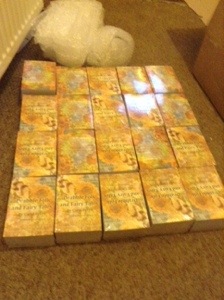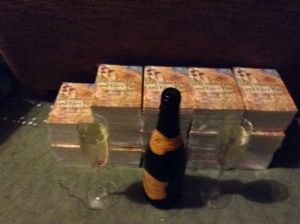I was the official blogger for the 300 Seconds event at SpacePortX in Manchester. Here are my blog notes from the event:
SpaceportX in Manchester was an excellent venue for the 300 Seconds event, with lots of audience participation led by compere Elizabeth Clark (CEO of Dream Agility).
Victoria Sorzano (BBC) 5 things you should know about Ada Lovelace
@vicsorzano http://digitalwitchnorth.com/
First up was the lovely Victoria Sorzano (BBC), who confidently led us through a fascinating synopsis of the life of Ada Lovelace, as the event was held on Ada Lovelace Day.
Ada Lovelace was a pioneer, the first person to write a computer program, working closely with Charles Babbage. She was the daughter of Lord Byron, though he left when Ada was young and she was brought up by her mother. Ada’s mother encouraged the very intelligent Ada to pursue studies in Maths and Science, and steered her away from the arts, though Ada showed her creative side in the elegance of her computer algorithms. Ada died of cancer aged 36, though her life was not all plain sailing. She was known to have had affairs, and was clearly dissatisfied with elements of her life.
Victoria ended her talk by showing us a funny extract from the graphic novel series “Goth Girl” (Illustrated by Chris Riddell) featuring Ada as the character “Ada Goth”.
Gemma Sou (Viva Voce podcasts) Viva Voce: a new social network for social scientists
@gemmasou @vivavocepodcasts http://www.vivavocepodcasts.com/
Gemma Sou spoke about how she developed a new social network which enables research students to disseminate their work across the academic community.
While studying for her Doctorate, she reviewed her online profiles, but couldn’t find an existing network to share her work that didn’t read “like an online CV”. She decided to set up her own solution to this problem, choosing to use 4-minute podcasts to summarise a variety of research topics. Each member of the social network can choose up to four key search terms for their work, encouraging interdisciplinarity and recognising that research often spans multiple subject areas. The podcasts are long enough to get a feel for the subject, while short enough to keep the interest of people outside the field of study.
Gemma hopes this network will rapidly expand, and encouraged the audience to spread the word.
Rachael Ball (BDB Marketing) What does a digital project manager do? A window into my world
@rachael_a_ball
Rachael used clear graphics and imaginative illustrations to show us the various aspects of her role as a digital project manager. She took us through the process of driving a project, from balancing the expectations of all the parties involved in the project to juggling the timescales and workload across concurrent projects. She showed how keeping “two or three steps ahead” helps drive projects forward, anticipating problems and preparing for eventualities. She explained the importance of empathy in dealing with clients, an understanding that their digital knowledge is not the same as hers, and the need for regular face-to-face meetings to avoid confusion about the project’s aims and progress.
Paula Moughton-Weems (Thoughtworks) Making the impossible possible
@iamPaulaMW @thoughtworks
Paula Moughton-Weems spoke about her journey into the field of tech (beginning her talk with a description of her journey across an actual field!)
From humble beginnings, Paula knew she wanted to have an impact on people’s lives, but did not follow the traditional University route into Tech. She met people who worked in software, and knew she wanted to be a part of that world, so she applied for a job at Thoughtworks, not expecting to actually get the job as she lacked the qualifications and experience of her competitors. Nevertheless, the Thoughtworks team wisely saw her passion and potential and hired her. Paula’s first impossible thing was “Don’t let them know I have no idea what I’m doing!” She faced a steep learning curve, with plenty of trial and error and asked lots of questions. She knew that asking questions would get her the information she needed, but without knowing what she didn’t know, how could she know what to ask? Her next impossible challenge came when Paula was asked to train up an intern. She didn’t feel she had the expertise to train someone else, but very quickly found that the best way to learn is to teach. When the intern asked a question she couldn’t answer, they found out together!
Paula is glad that Thoughtworks believes in passion and potential, and says she now gets to make an impact on the world because she faced those seemingly insurmountable challenges and “made impossible things possible.”
Verity Stockdale (BBC) Technology and Language
@veritystockdale
“What have technology and language got to do with each other?” Verity explored the complex relationship between these seemingly distant topics. Repurposing language is far from a new thing: in fact neologisms have been giving language purists trouble since at least the 16th Century! As new technology develops, language needs to adapt to adequately describe new ideas and ways of working.
Verity referred the audience to Tom Chatfield’s book, “Netymology” http://www.amazon.co.uk/gp/product/1780879938 which shows the long history of words most people assume to be brand new. For example, the first recorded use of O.M.G. as an acronym was way back in 1917, and the “Smiley” 🙂 has been in use since the 19th Century. Mostly, language innovation is viewed as inevitable and indeed a necessary part of societal change, but there are some who are vehemently opposed to the alteration of language.
In France, the “Académie Franҫaise” (known as ‘Les Immortels’ – sounds like something out of Twilight!) guard the purity of the French language, with varying degrees of success. The ‘pure’ French equivalents of popular modern terms were certainly a mouthful, it’s no wonder they didn’t catch on.
Verity showed how neologisms can follow rules, so even brand new words are understandable. She gave the example of an e-sofa. Language and technology are more closely linked than you think, as one changes and develops, inevitably the other will too.
Viv Slack (Code Computerlove) If you build it, will they come?
@vivslack @givingevents http://vivslack.com
The theory behind ‘Giving Events’ is simple: you do something, other people enjoy it, they donate money to a worthy cause.
Viv researched existing platforms, but couldn’t find anything that bridged the gap between organising events and giving money. Her top tip when setting up something new such as this was ‘ask friends for help!’ A friend helped her design the site, and soon it was up and running.
Viv finds it satisfying to see people having new experiences (an overseas student’s first glimpse of English countryside at Edale for example) but her current challenge is getting the site more widely known, beyond the sphere of her personal influence. She is bursting with ideas, and urged us all not to give up if an idea doesn’t succeed, but to move on and create the next new idea!
Nour Alomary Everyday digital security
@N_alomary
Nour spends a lot of time on public transport, where she sees many people using technology. She has had ample opportunity to learn strangers’ passcodes, as they type them in slowly in public! Luckily, Nour is not a criminal, and used her experience to help the audience stay safer online.
Her useful advice included an insight into the ways hackers crack passwords, and a warning not to use “really obvious” passwords such as ‘password1234’ or ‘your pet’s name, and the date you got your pet’ (at this point, several gasps rose from the audience as they realised their ‘terribly safe’ passwords were anything but). She advised using phrases instead of dictionary words, and adding numbers and characters, with the exception of replacing ‘o’ with zero (hackers have technology that can see through that). Several of the audience changed their passwords after Nour’s talk, so while her advice is not complex it is clearly necessary!
Emma Madden couldn’t make it, so we went straight to the final speaker, Lizzie Dyson
Lizzie Dyson(Ladies that UX) BBC Sports Persona refresh in 6 weeks
@lizziedyson @LadiesthatUXMCR @BBCSport
Lizzie started her talk by showing us the ‘before’ pictures of uninspiring personas for the BBC Sports site. They were DULL, and needed an urgent facelift. The information contained in the personas was factual and adequate, but needed to appeal to a discerning online audience, thus began a 6-week process to refresh the personas.
The first step was to commandeer a corridor wall and cover it in post-it notes of different colours to denote different things. Passers-by were intrigued by the spectacle, and were wisely roped into informal interviews, informing the content. The public were consulted about the personas, with Stakeholders looking on through one-way glass. Lizzie noted that the public were an important part of the process, and it was important for the stakeholders to see their views, as ‘stakeholders tend to think that everyone thinks like them’ and real users are more diverse.
Once the consultation was over, the story-building began. All flat surfaces were covered with strips of paper, dubbed ‘post-it porn’ by Lizzie and the team. The strips of paper were shuffled around to make engaging stories for each persona, then the content was made into web pages. A ‘naming ceremony’ was held, where the team showcased the personas and explained the reasons behind each one, then the personas were formally launched.
All in all, Lizzie provided an engaging, humorous account of the process, and showed how there’s far more to a persona than bare facts on a page.




![IMG_0821[1]](http://www.shortstorylady.co.uk/wp-content/uploads/2013/02/IMG_08211.jpg)
![IMG_0782[1]](http://www.shortstorylady.co.uk/wp-content/uploads/2013/01/IMG_07821-300x225.jpg)